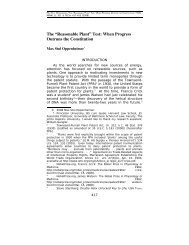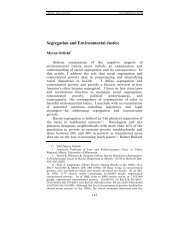An Organizational Approach to the Design of Patent Law
An Organizational Approach to the Design of Patent Law
An Organizational Approach to the Design of Patent Law
You also want an ePaper? Increase the reach of your titles
YUMPU automatically turns print PDFs into web optimized ePapers that Google loves.
6 VERTINSKY FINAL_JAD (DO NOT DELETE) 2/27/2012 2:20 PM<br />
2012] AN ORGANIZATIONAL APPROACH 259<br />
nities for more refined strategies should be explored. 209 These<br />
strategies need <strong>to</strong> encompass evolving innovation paradigms<br />
and <strong>the</strong> multi-faceted nature <strong>of</strong> innovative activity. 210 They<br />
need <strong>to</strong> respond <strong>to</strong> multiple innovative communities, including<br />
commercial firms, scientific researchers, user innova<strong>to</strong>r communities,<br />
and open source proponents. 211<br />
I suggest that disagreement persists about <strong>the</strong> type and<br />
level <strong>of</strong> tailoring <strong>of</strong> patent law that should occur in part because<br />
explanations <strong>of</strong> how patents change innovation are inadequate.<br />
By targeting <strong>the</strong> organization <strong>of</strong> innovation as <strong>the</strong> focus <strong>of</strong> patent<br />
policy, <strong>the</strong> organizational approach <strong>of</strong>fers a coherent<br />
framework for examining ways in which patent law should be<br />
tailored <strong>to</strong> fit different contexts. 212 A central premise <strong>of</strong> <strong>the</strong> organizational<br />
approach is that patent law should be designed in<br />
light <strong>of</strong> and be tailored <strong>to</strong> <strong>the</strong> distinct needs <strong>of</strong> alternative innovation<br />
processes. Selection among alternative approaches<br />
should be informed by fac<strong>to</strong>rs such as information asymmetries,<br />
<strong>the</strong> nature and specificity <strong>of</strong> investments required, <strong>the</strong><br />
importance <strong>of</strong> informal rules in shaping relationships among<br />
participants, and <strong>the</strong> structure <strong>of</strong> <strong>the</strong> markets within which<br />
such activities take place. Moreover, patent law needs <strong>to</strong> be responsive<br />
and adaptable <strong>to</strong> emerging modes <strong>of</strong> innovation. In<br />
some cases, such as <strong>the</strong> evolution <strong>of</strong> standard setting organizations<br />
<strong>to</strong> address <strong>the</strong> coordination needs <strong>of</strong> related technologies,<br />
this may mean limiting regulation <strong>to</strong> provide greater opportunities<br />
for private ordering, but with some protection against<br />
209. Carroll, for example, advocates a pragmatic, evidence-based economics<br />
approach <strong>to</strong> tailoring measures, which takes in<strong>to</strong> account information costs<br />
relating <strong>to</strong> who can pick <strong>the</strong> winning technologies and <strong>the</strong> cost and political<br />
feasibility <strong>of</strong> tailoring measures. See Michael W. Carroll, One Size Does Not Fit<br />
All: A Framework for Tailoring Intellectual Property Rights, 70 OHIO ST. L.J.<br />
1361, 1410–1414 (2009) (advocating for a pragmatic, evidence-based economics<br />
approach as basis for selecting among tailoring policies. Fac<strong>to</strong>rs include questions<br />
<strong>of</strong> who has <strong>the</strong> best information, costs <strong>of</strong> administering <strong>the</strong> system, and<br />
considerations <strong>of</strong> political economy).<br />
210. While innovation and economic growth are sometimes referred <strong>to</strong> almost<br />
interchangeably as desired outcomes <strong>of</strong> <strong>the</strong> patent system, for example,<br />
innovation is only one fac<strong>to</strong>r in economic growth and does not always result in<br />
what we might think <strong>of</strong> as economic growth. There may also be non-economic<br />
objectives or values <strong>to</strong> address, such as issues <strong>of</strong> equity and a transformational<br />
impact <strong>of</strong> certain kinds <strong>of</strong> property rights, which need <strong>to</strong> be captured in <strong>the</strong><br />
analysis <strong>of</strong> patent policy.<br />
211. Strandburg, supra note 44, at 867.<br />
212. See, e.g., Burk & Lemley, supra note 22, at 1578.






